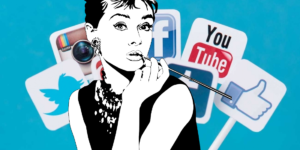Technology might not be directly tied to fashion, but it has had tremendous impacts on the fashion industry. Even just a decade back, ecommerce was unheard of, marketing budgets went towards fashion weeks and storefronts, and inventory took about 2 years to go from concept to the shelf.
In this modern world, clothing is powered by data, with Zara famously changing its product offerings every 14 days. Even more, social media has shaped both the business practices of fashion brands and consumer preferences. Since young people can now easily see what people are wearing and how different styles perform based on likes, shares, and influencer endorsement.
I sat down with the founder of DHTK, Elie Neufeld, to discuss how he sees social media shifting the fashion world and he has worked to develop and launch his brand in a digital era.
1. Fashion lifecycles are shortening.
Due to the rapid dispersion of information on social media, it has become easier than ever for new fashion brands to startup and for unique styles to be shared. This means that both the fashion calendar is changing and general lifecycles for trends are getting shorter. One of the best examples of this is with streetwear and “athleisure.” Athleisure refers to the lifestyle behind yoga pants, gym shorts, joggers, and overall athletic gear worn more for comfort and style associations than for the purpose of exercising.
In 2015, most fashion brands finally acknowledged the superiority of “athleisure” as a dominant trend. However, even just two years later, athleisure has hit the curb and is replaced by streetwear.
Whereas Lululemon was a dominant fashion brand in 2015, Supreme reigns in 2017. Yet, the times are changing already and streetwear is quickly shifting from skateboarding influence to cultural influence.
Before the age of social media, brands and styles would last years and decades rather than pivot multiple times per years.
This has made DHTK pay close attention to style and cultural events to ensure they never miss changes in the fashion lifecycle. Whenever a major cultural event happens or new look comes into style, DHTK pays attention and adapts to the ever-changing environment.
2. Youth is powering style.
If you think back a few decades, major fashion houses were run by older men and the cost of launching of a brand was so high, that fashion players had to go through established avenues in order to rise the ranks.
In the age of social media, not only has it become easy to launch a brand or gain brand awareness, but the social media power-users are truly the ones pushing forward design trends.
Kendall Jenner and Gigi Hadid have developed careers as both style influencers and runway models due to their ability to shape consumer preferences through their social media channels. In fact, most of the powerful fashion players are youthful. This is largely due to performance on social media being important for curating style and pushing brand sales.
3. Unique self-expression is key.
As young people become more obsessed with technology and Gen Z is on average spending 8 hours or more in front of screens, they have begun to approach fashion in a different manner. Just as wearing the same shirt as a classmate was a disaster in school, young people need to have entirely separate styles online, because posting a picture with the same outfit as someone is a disaster. This has led to people viewing social media as requiring unique self-expression and completely distinct styles.
What is even more evident with this progression of fashion styles becoming even more niche, is that fashion brands can now pop-up and build a following around specific lifestyles. No longer does a brand need to appeal to millions of people in order to make a profit. Rather, finding an intensely passionate group of consumers is sufficient to reify a brand. This has led to the development of lifestyle brands that cater to specific individual needs.
For instance, DHTK helps channel a vibe of personal empowerment shared by many athletic individuals. Its ability to move beyond just the fashion and truly create a product to engage with a specific lifestyle has helped build brand engagement and cater to its specific audience. Elie recommends brands take the initiative to think about everything its consumer enjoy doing, beyond just the clothing, because “that added depth will help your brand thrive.”
Digital trends have become one of the most important things for fashion brands to understand in order for them to succeed. Social media in particular has shifted the paradigms of the fashion world and DHTK has displayed how entrepreneurs can leverage these changes to find success.








